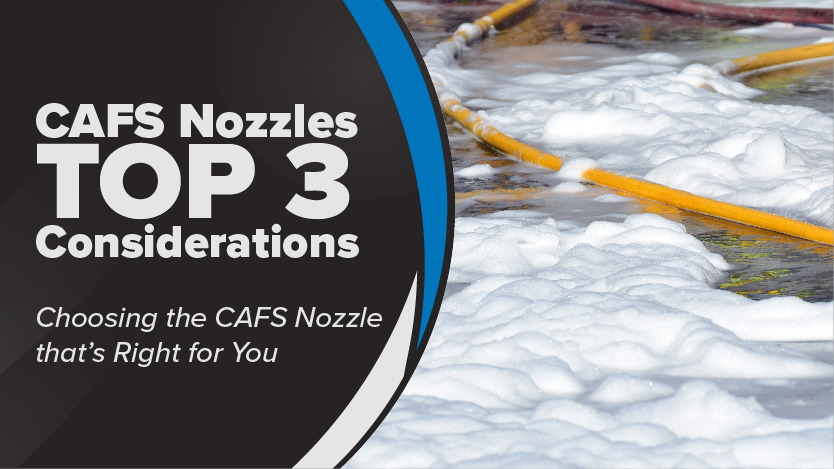3 Considerations When Choosing a CAFS Nozzle
A key component of successful fireground application of compressed air foam is using a high-performance nozzle. Nozzle selection plays an important role in your fire department’s Compressed Air Foam System (CAFS) implementation program. During the nozzle selection process, buy-in from your firefighting teams on a final nozzle choice is challenging yet critical.
Today, nozzle selection remains a highly personal choice for each fire department and is dependent upon a host of local factors. Let’s look at factors and considerations in making the best choice.
The best nozzle choice depends on several issues. Here are three of the most important:
Meeting target compressed air foam delivery rates
Target delivery rate of compressed air foam is measured in both gallons per minute (gpm) of foam solution and cubic feet per minute (cfm) of compressed air output for a given diameter hose line or monitor. For example, deploying a 1-3/4-inch diameter hand line for initial fire attack, the author uses a 120 gpm/60 cfm target delivery rate applied through a pistol grip ¼-turn ball valve with a 1-3/8-inch inside diameter bore, no smooth-bore nozzle attached. This configuration does not work for everyone. You can find further discussion in our How Do Compressed Air Foam Systems Work article.
Operator skill in controlling the CAFS pump
Many systems require additional pump operation steps to be completed in a specific sequence to deliver compressed air foam. Failure to perform each step in the correct order may cause unwanted consequences, such as delivery of foam solution only, air only, or air and water only (no foam agent).
When considering nozzle selection, you should ask yourself: What is the confidence level that pump operators will deliver compressed air foam, first time, every time?
The answer weighs heavily into nozzle design choice. For example, on a handline, a smooth bore nozzle may be a good choice if pump operators are highly proficient. If not, using a specifically designed variable gallon nozzle used in the “flush” setting may be a good choice. If compressed air foam delivery problems occur, the nozzle operator can immediately adjust the setting from “flush” to a 125- or 95-gpm setting to maintain an effective fire stream. This option is further discussed in our article on Evaluating CAFS Nozzles.
CAFS design and required maintenance
Is the CAFS unit operated and exercised on a regular basis? Are the manufacturer’s maintenance recommendations followed? If so, how reliable is the system? Does the equipment produce the desired type of finished foam — wet, fluid, or dry — consistently? If any of these are problem issues, an adjustable gallon nozzle may be the best choice.
Further Reading
Selecting a nozzle for your compressed air foam system requires careful thought and consideration. It may help to review nozzle aspirated foam systems (NAFS) to understand why nozzles for CAFS have significantly different requirements.
